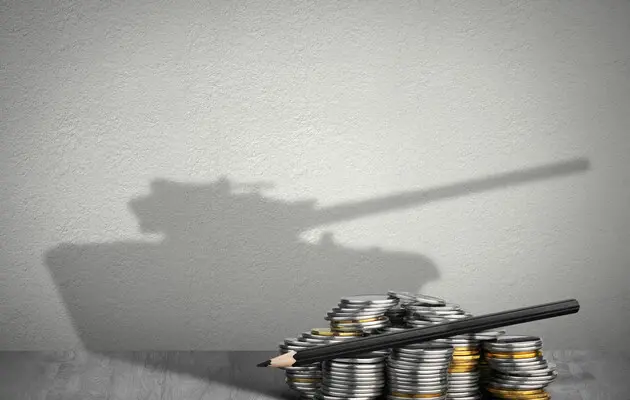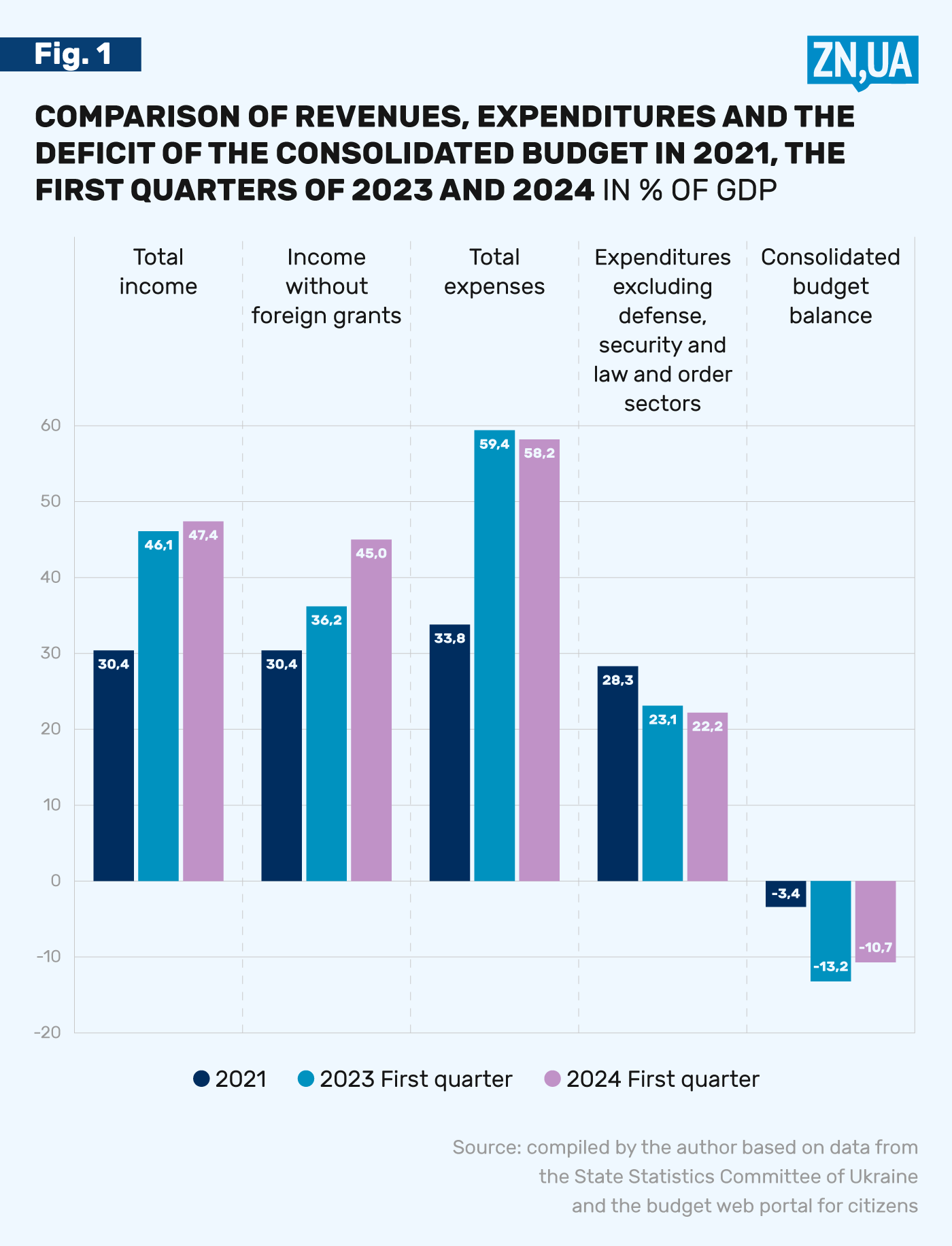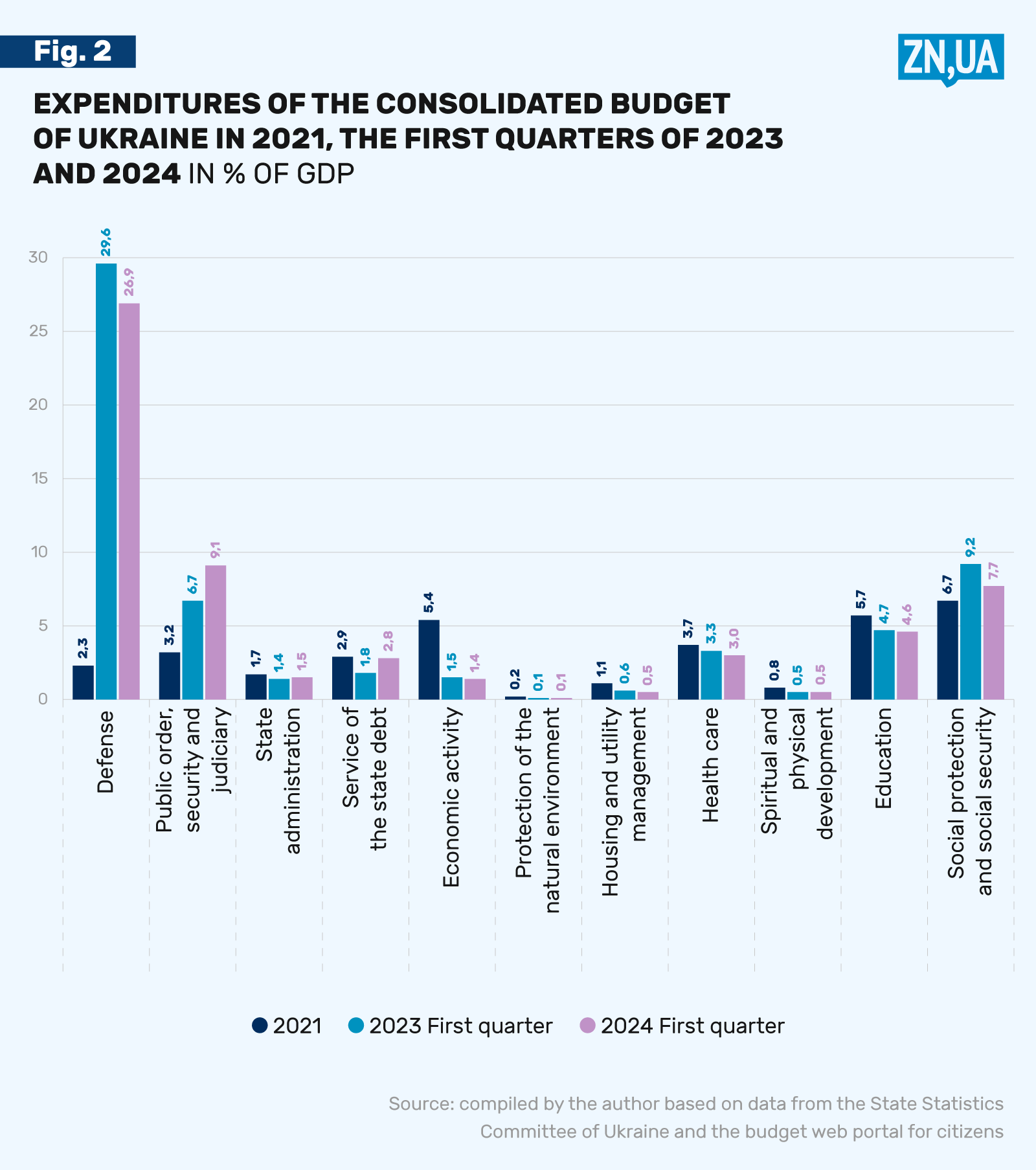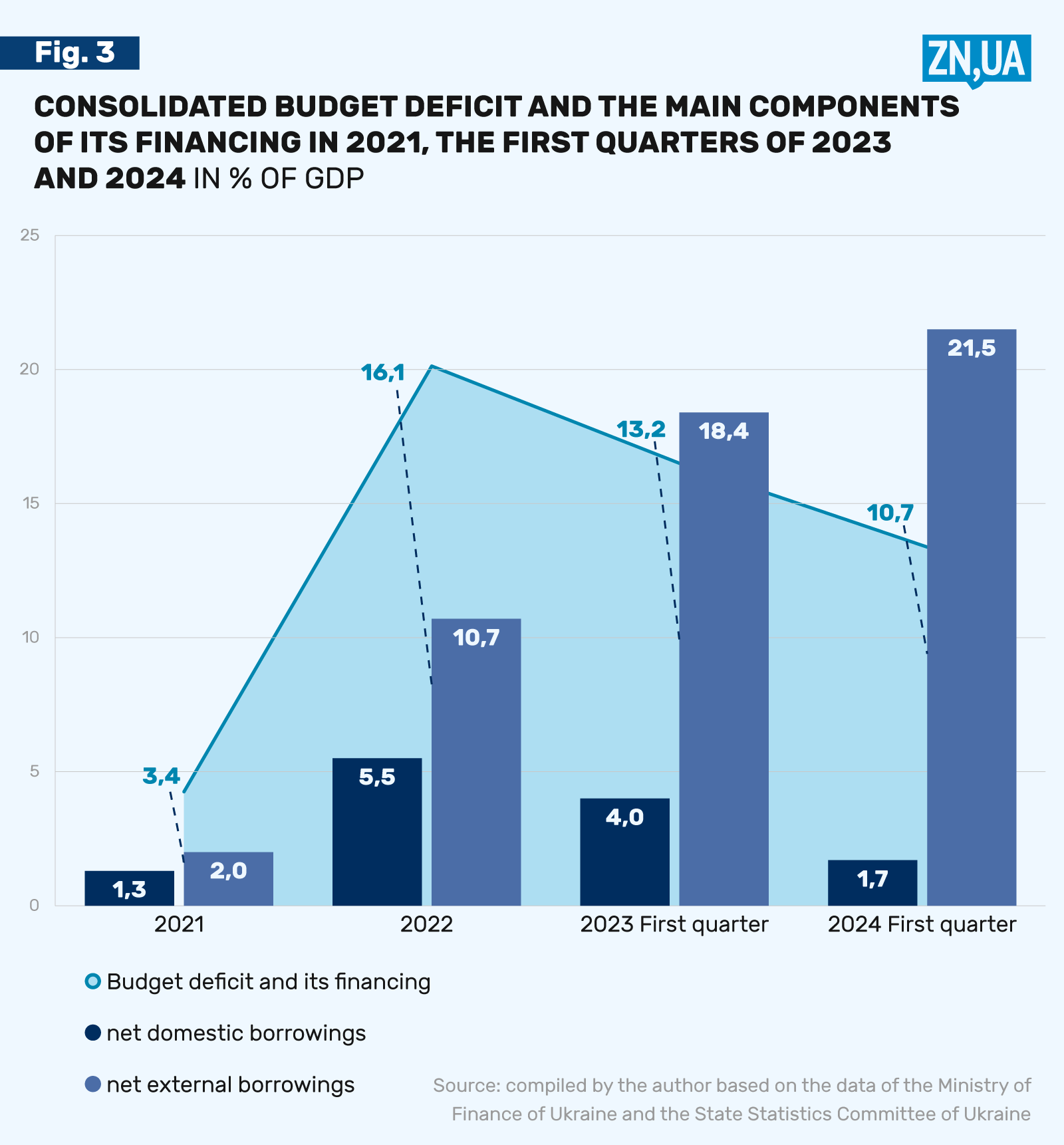The budget and debt of the protracted war
Indicators of budget revenues in January-March 2024 slightly improved, while expenditures slowly decreased. However, budget imbalances remained significant, and Ukraine's public debt continued to grow. The need to conduct prolonged military operations to fight the aggressor requires both the consolidation of internal efforts and the further involvement of external assistance.
Revenues of the consolidated budget of Ukraine, taking into account grants, in the first quarter of 2024 were at the level of 47.4% of Gross domestic product (GDP) and exceeded the pre-war level by one and a half times. Excluding foreign grants, budget revenues increased from 30.4% of GDP in 2021 to 36.2% of GDP in the first quarter of 2023 and to 45% of GDP in the first quarter of 2024 (see Fig. 1).
An important component of the increase in budget revenues was tax revenues, which increased by 6.2 percentage points of GDP compared to the first quarter of 2023. At the same time, revenues from value-added tax (VAT) increased by 2.5 percentage points of GDP (to 11.3% of GDP), and revenues from corporate income tax increased by 4 percentage points (to 6.8% of GDP). The one-time taxation of banks' profits for 2023 at the rate of 50% explained the phenomenon of a sharp increase in income tax. Income from the personal income tax did not undergo significant changes, but the personal income tax from the military began to be fully credited to the state budget.
Funds belonging to the special fund in the part of charitable contributions and the transfer of military equipment (in the budget classification – "other sources of personal income of budget institutions") became an important component of budget revenues. In the first quarter of 2024, this source provided 7.8% of GDP revenue to the budget.
Continuation of significant international support for Ukraine fueled consumption and investment expenditures of the budget. Although the receipt of this support was extremely uneven and complicated the planned implementation of the budget. In the first quarter of 2024, the budget received 10.2 billion dollars. in the form of foreign loans and grants, but their delays in January-February 2024 prompted the government to create incomplete financing of planned budget expenditures and withdrawal of funds from treasury accounts.
The relative volume of budget expenditures during the war almost doubled – from 34% of GDP in 2021 to 58–59% in the first quarter of 2023 and 2024. This increase was explained solely by the increased needs of the security, defense and law enforcement sector. And budget expenditures on social and economic programs have even decreased – from 28% of GDP in 2021 to 22–23% of Gross domestic product (GDP) in the first quarter of 2023 and 2024.
In fig. 2 shows the relative amount of budget expenditures by state functions during 2021–2024. The most noticeable increase was in defense spending – from 2.3% of GDP in 2021 to 27–29.6% in January–March 2023–2024. Expenditures on public order and security increased almost three times to 9.1% of GDP.
In order to compensate for the increased costs, the state was first forced to reduce expenditures on economic activity – from 5.4% of Gross domestic product (GDP) in 2021 to 1.4% in 2024 and on education — from 5.7% of GDP in 2021 to 4.6% in 2024. Health care financing decreased from 3.7 to 3% of GDP. The fall in state investment in the accumulation of human capital during the war could hardly be avoided. But the chronically protracted nature of these processes will have irreversible destructive consequences for Ukraine.
Expenditures on social protection and provision in the first quarter of 2024 were financed at the level of 7.7% of Gross domestic product (GDP), which is slightly higher than in 2021, but does not reach the level of 2023. Expenditures of this type grew due to payments to internally displaced persons, disability benefits and loss of a breadwinner.
Despite the multiple increase in the volumes of the state defense order, it ensured the supply under the contract of only a third of the products that could potentially be produced by domestic enterprises of the defense industrial complex. Ukrainian budget expenditures on security and defense in 2024 are planned in the amount of 46 billion dollars, and expenditures of the aggressor's budget – 115 billion dollars. Military aid provided by the United States of America to Ukraine in the amount of 47 billion dollars (approved in April 2024) reduces this gap, but does not close it completely.
One of the factors of insufficient budget funds for the basic needs of the warring country is the rapid growth of expenses for the payment of interest on the domestic debt. In absolute terms, they increased from UAH 17.4 billion in the first quarter of 2021 to UAH 27.3 billion in the first quarter of 2024. The annual value of these expenditures in 2024 should reach UAH 260.3 billion.
The determinants of the increase in interest payments are keeping the discount rate of the National Bank of Ukraine (NBU) at a high level and offering banks high-yield certificates of deposit of the National Bank of Ukraine (NBU), which are direct competitors of short-term bonds of domestic state loans of Ukraine. As a result, the weighted average bond placement rate of Ukraine's domestic state loan increased from 11.4% in 2021 to 18.7% in 2023 and 17.3% per annum in January-April 2024.
The real discount rate of the National Bank of Ukraine (NBU) at the end of 2023 was 9.9% per annum based on ex post inflation and 6.4% based on ex ante inflation. Having experienced a drop in real amount of Gross domestic product (GDP) by almost a third, the economy of Ukraine has been operating in the regime of abnormally high interest rates for two years. In April 2024, after the reduction of the nominal discount rate to 13.5%, its real level still exceeds 10% per annum.
It is significant that among countries with emerging markets, the average level of real rates of central banks (ex-post) in 2023 was only +1.0%, and among developed countries – 1.3% per annum. At the same time, the most monetarily cautious countries were: Bulgaria (with a rate of -6.5%), Serbia (-5.9), Sweden (-4.8), Poland (-4.8), Hungary (-4.0), Moldova (-3.9), Czech Republic (-3.5%).
Exaggeration of interest rates on the domestic public debt in Ukraine obviously worsens the economic stability and defense capability of the country during the war.
As of April 1, 2024, state and state-guaranteed debt reached UAH 5.9 trillion, or 90.6% of GDP last year. Compared to the beginning of 2022, the amount of debt increased by UAH 3.3 trillion. And the currency equivalent of the state debt increased by 40 billion dollars during the same period.
An alarming symptom of worsening debt problems of Ukraine is the decision of the Congress of the United States of America to provide financial assistance to Ukraine not in the form of grants, as it was before, but in the form of loans. This decision will increase the public debt of Ukraine by 7.8 billion dollars in 2024 alone, or by 5% of our Gross domestic product (GDP). As a result of this decision, the share of grants in the structure of external official financing of Ukraine will also decrease manifold: from 29% in 2023 to 12% in 2024.
It is obvious to all sane people that maintaining the stability of Ukraine during the war and rebuilding its economy require attracting the maximum possible part of funds in the form of grants, not loans. After all, even after the end of the war, significant human and material losses from it will not enable our country to service the accumulated debts without problems. Unfortunately, the narrowly selfish interests of the ruling elite of the West often prevail in matters of support for Ukraine.
In addition, at the beginning of 2022, the public debt of Ukraine was 49% of Gross domestic product (GDP), and in three years it will approach 100% of GDP. Excessive reliance on loans increases the risk of state insolvency and negatively affects the decisions of private investors. This will undermine the internal investment process and inhibit the attraction of foreign investment to the economy even after the end of the war.
Experts of the International Monetary Fund (IMF), having conducted a comprehensive analysis of Ukraine's debt sustainability in March 2024, concluded that guaranteeing the solvency of the state will require a reduction in the level of public debt to 82% of Gross domestic product (GDP) in 2028 and to 65% of GDP in 2033.
For the economic revival of the country and the restoration of debt sustainability, the restructuring of Ukraine's external public debt on significantly preferential terms in both 2024 and 2026, as well as a significant increase in the share of grants in the structure of external official financing, are critically necessary.
Gross state loans increased significantly during the war. Thus, the government borrowed UAH 0.6 trillion from external and internal sources in 2021 and UAH 1.7 trillion in 2023. In the first quarter of 2024, gross loans amounted to UAH 0.5 trillion. At the same time, the importance of external loans has increased significantly: their share has increased from 30% of total loans in 2021 to 75% in 2024.
In January-March 2024, net foreign loans (excluding debt repayments) reached a colossal value of 21.5% of Gross domestic product (GDP). And net domestic loans amounted to only 1.7% of GDP (see Fig. 3). The small capacity of the domestic state loan bonds of Ukraine market, their low maturity and high cost determined the modest role of domestic loans in financing the deficit. With the total amount of net borrowings to the budget of UAH 365.6 billion in 2024, domestic loans provided only UAH 27.5 billion of net financing.
The budget deficit in the first quarter of 2024 amounted to UAH 167 billion, or 10.7% of GDP, and was lower than the annual indicators of 2022 and 2023, but did not erase the soft nature of the fiscal policy. This policy supported consumer and investment demand in the country and acted as one of the factors of Gross domestic product (GDP) growth.
Unfortunately, starting this year, the stimulating effect of fiscal policy on the real economy will decrease. The memorandum with the International Monetary Fund (IMF) envisages the implementation of the budget consolidation policy with the improvement of the primary balance of the general government by 7.6% of Gross domestic product (GDP) in 2024 and by 5.4% of GDP in 2025. The memorandum also contains the maximum allowable value of the so-called non-defense primary deficit – expenditures not related to defense and interest payments, minus revenues. So, according to the results of 2024, this value should be negative and reach -5% of Gross domestic product (GDP).
In the future, the budget policy will reflect painful compromises between the needs of conducting military and defense actions and maintaining the socio-economic stability of the country. But the absolute priority during the war for the preservation of statehood should be adequate government financing of defense orders, investment support of state-owned military-industrial complex enterprises and incentives for private investors, financing of the construction of defense and fortification structures, and rationalization of debt service expenditures. In addition, it is also necessary to work out the issues of consumption taxes, resource and environmental taxes, and progressive taxation of the population's income in the context of increasing the country's economic self-sufficiency.
Please select it with the mouse and press Ctrl+Enter or Submit a bug















 Login with Google
Login with Google